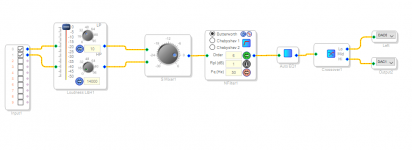I wanted to learn more about DSP, active cross-overs and equalization, so I purchased the inexpensive Dayton DSPB-250 and its programming board. About $50. I wasn't expecting much, it started as a learning experience. Boy was I wrong...........
I had a spare Jordan JX92S and a HiVi planar RT1C which I used to make a mono speaker for listening to podcasts and music in a workshop. Granted these are quite decent drivers that I am starting with, the Jordans are my favorite drivers.
The DSP system proved easy to learn and I was able to connect to Sigma Studio easily. This is a two channel amp and so one channel for the woofer and one for the tweeter. Cross-over at 5000 Hz.
With little effort I was able to use REW to create a frequency response and then use Sigma Studio to auto-equalize. The resulting response is quite flat from 65 to 20,000 and this is in my listening space. I then added a mono-mixer and loudness controls. The result is simple astounding and sounds as good as my Focal Aria home theater speakers.
I see comments about noise from this chip/amp but once disconnected from my noisy computer and using a better source this little amp is dead quite.
I highly recommend people try doing something like this. You cannot beat the experience for a $50 outlay. I find myself listening to this little speaker for hours while working and constantly tapping my feet to the beat.
I had a spare Jordan JX92S and a HiVi planar RT1C which I used to make a mono speaker for listening to podcasts and music in a workshop. Granted these are quite decent drivers that I am starting with, the Jordans are my favorite drivers.
The DSP system proved easy to learn and I was able to connect to Sigma Studio easily. This is a two channel amp and so one channel for the woofer and one for the tweeter. Cross-over at 5000 Hz.
With little effort I was able to use REW to create a frequency response and then use Sigma Studio to auto-equalize. The resulting response is quite flat from 65 to 20,000 and this is in my listening space. I then added a mono-mixer and loudness controls. The result is simple astounding and sounds as good as my Focal Aria home theater speakers.
I see comments about noise from this chip/amp but once disconnected from my noisy computer and using a better source this little amp is dead quite.
I highly recommend people try doing something like this. You cannot beat the experience for a $50 outlay. I find myself listening to this little speaker for hours while working and constantly tapping my feet to the beat.
